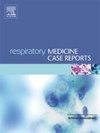PiComplutense (p.p pro393thr):在两个兄弟姐妹中发现了α -1抗胰蛋白酶缺乏症的一种新的SERPINA1变体
IF 0.7
Q4 RESPIRATORY SYSTEM
引用次数: 0
摘要
α -1抗胰蛋白酶缺乏症(AATD)是一种常见但未被充分认识的遗传疾病,易导致早发性肺气肿和肝脏疾病。诊断算法通常针对频繁的等位基因(S和Z),在表型不一致的患者中可能会遗漏罕见的变异。病例介绍:我们报告了两位生物学上相关的个体(姐妹),尽管最初为Pi * MZ基因型,但他们的血清AAT水平持续较低。纵向临床、功能和放射学评估显示了不同的轨迹:病例1无症状,肺功能稳定,影像学正常,而病例2发展为轻度肺气肿和进行性气流阻塞。两例患者血清AAT水平均显著降低(分别为60-61 mg/dL和57-50 mg/dL;参考范围:90-200 mg/dL)。鉴于表型-基因型不一致,进行了全基因测序,并在两姐妹中发现了先前未报道的SERPINA1变异,c.1177C > a (p.Pro393Thr),反式,与Z等位基因结合。正如已知致病性w本文章由计算机程序翻译,如有差异,请以英文原文为准。
PiComplutense (p.Pro393Thr): A novel SERPINA1 variant in Alpha-1 antitrypsin deficiency identified in two siblings
Background
Alpha-1 antitrypsin deficiency (AATD) is a common yet underrecognized genetic condition that predisposes to early-onset emphysema and liver disease. Diagnostic algorithms typically target frequent alleles (S and Z), potentially missing rare variants in patients with discordant phenotypes.
Case presentation
We report two biologically related individuals (sisters) referred to our respiratory outpatient clinic after persistently low serum AAT levels despite an initial Pi∗MZ genotype. Longitudinal clinical, functional, and radiological evaluation revealed divergent trajectories: Case 1 remained asymptomatic with stable lung function and normal imaging, while Case 2 developed mild emphysema and progressive airflow obstruction. Serum AAT levels were markedly reduced in both patients (60–61 mg/dL and 57–50 mg/dL, respectively; reference range: 90–200 mg/dL). Given the phenotype–genotype discordance, full-gene sequencing was performed and identified a previously unreported SERPINA1 variant, c.1177C > A (p.Pro393Thr), in trans, combined with the Z allele, in both sisters.
Discussion
Codon 393 is functionally relevant, as shown by the known pathogenic Würzburg variant (p.Pro393Ser). The location of the novel variant within beta-sheet C, its trans configuration with Z, the associated biochemical phenotype, and segregation in two related individuals support its likely pathogenicity. We propose the designation PiComplutense for this mutation.
Conclusion
These cases highlight the diagnostic value of extended SERPINA1 sequencing in patients with biochemical–genotypic discordance. Although the most frequent deficient alleles are S and Z, we should think about possible rare variants when discordance exists. There is a need to improve early detection, refine risk assessment and support personalised clinical management.
求助全文
通过发布文献求助,成功后即可免费获取论文全文。
去求助
来源期刊

Respiratory Medicine Case Reports
RESPIRATORY SYSTEM-
CiteScore
2.10
自引率
0.00%
发文量
213
审稿时长
87 days
 求助内容:
求助内容: 应助结果提醒方式:
应助结果提醒方式:


